Aggregation Strategy for Reactive Power Compensation Techniques—Validation
Abstract
1. Introduction
2. Proposed Coordinated Strategy
- Quick service is required in the case of contingencies and urgencies.
- Huge amount is required in the case of huge deviations.
- More efficiency is required to justify the better use of resources.
- Use of SG for normal conditions, with the addition of synchronous condensers for high steady state reactive power requirements.
- Addition of STATCOMs for more fast provision.
- The use of capacitor banks is eliminated, because reactive power depends on square of voltage, and hence it is not suitable for high and medium voltage applications.
- SVC is also eliminated due to the voltage non-linear dependency and the associated high costs for the investment.
- Inverters are skipped too due to the very low provision.
- Synchronous generators and synchronous condensers are the best in terms of steady state response.
- STATCOM performs best for the transient cases.
3. Test System Modeling
- Increase/decrease in reactive power for fast provision.
- Increase/decrease in reactive power for high provision.
- Increase/decrease in reactive power for distant provision. As reactive power is a local ancillary service, and for geographically distant (far) locations, the control has to be changed.
4. Validation of the Proposed Strategy
- There is no need to operate the STATCOM at POI, in order to avoid the operational and maintenance costs.
- The capital cost for STACOM installation at POI is very high.
- Capacitor bank gives a fast response, and almost linear response when compared to STATCOM.
5. Conclusions
Author Contributions
Funding
 Open-access publication charges has also received funding from the European Union’s Horizon 2020 research and innovation programme under the Marie Sklodowska-Curie grant agreement No 676042.
Open-access publication charges has also received funding from the European Union’s Horizon 2020 research and innovation programme under the Marie Sklodowska-Curie grant agreement No 676042.Conflicts of Interest
References
- Ali, J. Coordinated Control Mechanism for Voltage Stability Utilizing Aggregation of Reactive Power Compensation Techniques. In Proceedings of the IEEE International Conference on Environment and Electrical Engineering, Palermo, Italy, 12–15 June 2018; IEEE: Piscataway, NJ, USA. [Google Scholar] [CrossRef]
- Hossain, M.J.; Saha, T.K.; Mithulananthan, N. Impacts of wind and solar integrations on the dynamic operations of distribution systems. In Proceedings of the AUPEC Australasian Universities Power Engineering Conference, Brisbane, Australia, 25–28 September 2011. [Google Scholar]
- Wang, Y.; Yu, Y.; Zhang, J. Analysis for distribution network on hosting capacity of distributed wind turbines considering additional income under procedure conditions. J. Eng. 2017, 2017, 1373–1377. [Google Scholar] [CrossRef]
- Torquato, R.; Salles, D.; Pereira, C.O.; Meira, P.C.M.; Freitas, W. A Comprehensive Assessment of PV Hosting Capacity on Low-Voltage Distribution Systems. IEEE Trans. Power Deliv. 2018, 33, 1002–1012. [Google Scholar] [CrossRef]
- Arshad, A.; Lindner, M.; Lehtonen, M. An Analysis of Photo-Voltaic Hosting Capacity in Finnish Low Voltage Distribution Networks. Energies 2017, 10, 1702. [Google Scholar] [CrossRef]
- Bertini, D.; Moneta, D.; Carneiro, J.S.D.A.; Falabretti, D.; Merlo, M.; Silvestri, A. Hosting Capacity of Italian LV Distribution Networks. In Proceedings of the CIRED Conference, Frankfurt, Germany, 6–9 June 2011. [Google Scholar]
- Nassif, A. An Analytical Assessment of Feeder Overcurrent Protection with Large Penetration of Distributed Energy Resources. IEEE Trans. Ind. Appl. 2018, 54, 5400–5407. [Google Scholar] [CrossRef]
- Khademlahashy, A.; Li, L.; Every, N.; Zhu, J. A review on protection issues in micro-grids embedded with distribution generations. In Proceedings of the IEEE Conference on Industrial Electronics and Applications, Siem Reap, Cambodia, 18–20 June 2017; IEEE: Piscataway, NJ, USA. [Google Scholar] [CrossRef]
- Lew, D.; Asano, M.; Boemer, J.; Ching, C.; Focken, U.; Hydzik, R.; Lange, M.; Motley, A. The Power of Small: The Effects of Distributed Energy Resources on System Reliability. IEEE Power Energy Mag. 2017, 6, 50–60. [Google Scholar] [CrossRef]
- Baboli, P.T. Flexible and overall reliability analysis of hybrid AC-DC microgrid among various distributed energy resource expansion scenarios. IET Gener. Transm. Distrib. 2016, 10, 3978–3984. [Google Scholar] [CrossRef]
- Yang, J.; Wang, Y. A review of the effects of distributed energy resources and power-electronic controlled loading on distribution network stability. In Proceedings of the IEEE Conference on Industrial Electronics and Applications, Hangzhou, China, 9–11 June 2014; IEEE: Piscataway, NJ, USA. [Google Scholar] [CrossRef]
- Shi, L.; Sun, S.; Yao, L.; Ni, Y.; Bazargan, M. Effects of wind generation intermittency and volatility on power system transient stability. IET Renew. Power Gener. 2014, 8, 509–521. [Google Scholar] [CrossRef]
- Kanchanaharuthai, A.; Chankong, V.; Loparo, K. Transient stability and voltage regulation in power systems with renewable distributed energy resources. In Proceedings of the EnergyTech Conference, Cleveland, OH, USA, 25–26 May 2011; IEEE: Piscataway, NJ, USA. [Google Scholar] [CrossRef]
- Cutsem, T.V.; Vournas, C. Voltage Stability of Electric Power Systems; Springer: New York, NY, USA, 1998. [Google Scholar] [CrossRef]
- Chanhome, A.; Phichaisawat, S.; Chaitusaney, S. Minimization of voltage fluctuation by considering uncertainty from Renewable Energy Resources. In Proceedings of the ECTICon Conference, Krabi, Thailand, 15–17 May 2013; IEEE: Piscataway, NJ, USA. [Google Scholar] [CrossRef]
- Aziz, T.; Ketjoy, N. PV Penetration Limits in Low Voltage Networks and Voltage Variations. IEEE Access 2017, 5, 16784–16792. [Google Scholar] [CrossRef]
- Vilman, A.; Jerele, M. Voltage quality provision in low-voltage networks with high penetration of renewable production. CIRED—Open Access Proc. J. 2017, 2017, 2053–2056. [Google Scholar] [CrossRef]
- Liang, X. Emerging Power Quality Challenges Due to Integration of Renewable Energy Sources. IEEE Trans. Ind. Appl. 2017, 53, 855–866. [Google Scholar] [CrossRef]
- Zotti, G.D.; Pourmousavi, S.A.; Madsen, H.; Poulsen, N.K. Ancillary services 4.0: A top-to-bottom control-based approach for solving ancillary services problems in smart grids. IEEE Access 2018, 6, 11694–11706. [Google Scholar] [CrossRef]
- Rebours, Y.G.; Kirschen, D.S.; Trotignon, M.; Rossignol, S. A survey of frequency and voltage control ancillary services—Part II: Economic features. IEEE Trans. Power Syst. 2007, 22, 358–366. [Google Scholar] [CrossRef]
- Renedo, J.; Garcia-Cerrada, A.; Rouco, L. Reactive Power Coordination in VSC-HVDC Multi-Terminal Systems for Transient Stability Improvement. IEEE Trans. Power Syst. 2017, 32, 3758–3767. [Google Scholar] [CrossRef]
- Mei, S.; Ni, Y.; Wang, G.; Wu, S. A Study of Self-Organized Criticality of Power System Under Cascading Failures Based on AC-OPF With Voltage Stability Margin. IEEE Trans. Power Syst. 2008, 23, 1719–1726. [Google Scholar] [CrossRef]
- Saadat, H. Power System Analysis, 3rd ed.McGraw Hill: New York, NY, USA, 1999. [Google Scholar]
- Kaloudas, C.G.; Ochoa, L.F.; Marshall, B.; Majithia, S.; Fletcher, I. Assessing the Future Trends of Reactive power Demand of Distribution Networks. IEEE Trans. Power Syst. 2017, 32, 4278–4288. [Google Scholar] [CrossRef]
- Chen, Y.C.; Dhople, S.V. Power Divider. IEEE Trans. Power Syst. 2016, 31, 5135–5143. [Google Scholar] [CrossRef]
- Corsi, S.; Pozzi, M.; Sabelli, C.; Serrani, A. The coordinated automated voltage control of the Italian transmission grid-part I: Reasons of the choice and overview of the consolidated hierarchical system. IEEE Trans. Power Syst. 2004, 19, 1723–1732. [Google Scholar] [CrossRef]
- Grid Code, Italian TSO. Available online: https://www.terna.it/en-gb/sistemaelettrico/codicedirete.aspx (accessed on 28 March 2019).
- Haberg, M.; Bood, H.; Doorman, G. Preventing internal congestion in an integrated European balancing activation optimization. Energies 2019, 12, 490. [Google Scholar] [CrossRef]
- Mokkapaty, S.; Weiss, J.; Schalow, F.; Declercq, J. New generation voltage regulation distribution transformer with an on load tap changer for power quality improvement in the electrical distribution systems. CIRED—Open Access Proc. J. 2017, 2017, 784–787. [Google Scholar] [CrossRef][Green Version]
- Zimmer, H.; Niersbach, B.; Hanson, J. Optimization of power plant AVR parameters to improve transient voltage stability. In Proceedings of the CPE-POWERENG Conference, Cadiz, Spain, 4–6 April 2017; IEEE: Piscataway, NJ, USA. [Google Scholar] [CrossRef]
- Mohanty, A.; Behera, R.; Panigrahi, B. Fuzzified Philip_Heffron model power system stabilizer for improvisation of Voltage stability. In Proceedings of the ICEEOT Conference, Chennai, India, 3–5 March 2016; IEEE: Piscataway, NJ, USA. [Google Scholar] [CrossRef]
- Igbinovia, F.O.; Fandi, G.; Ahmad, I.; Muller, Z.; Tlusty, J. Modeling and Simulation of the Anticipated Effects of the Synchronous Condenser on an Electric-Power Network with Participating Wind Plants. Sustainability 2018, 10, 4834. [Google Scholar] [CrossRef]
- Igbinovia, F.O.; Fandi, G.; Mller, Z.; Svec, J.; Tlusty, J. Cost implication and reactive power generating potential of the synchronous condenser. In Proceedings of the IGBSG Conference, Prague, Czech Republic, 27–29 June 2016; IEEE: Piscataway, NJ, USA. [Google Scholar] [CrossRef]
- Wenzel, T.; Leibfried, T. Voltage stability with mechanically switched capacitors using Vacuum Circuit Breakers in the High-Voltage Grid. In Proceedings of the International Conference on Optimization of Electrical and Electronic Equipment, Basov, Romania, 20–22 May 2010; IEEE: Piscataway, NJ, USA. [Google Scholar] [CrossRef]
- Wang, K.; Ye, M.; Xiong, W.; Wang, F.; Hou, J. Coordinated control of STATCOM and mechanically switched capacitors to improve short-term voltage stability. In Proceedings of the POWERCON Conference, Wollongong, Australia, 28 September–1 October 2016; IEEE: Piscataway, NJ, USA. [Google Scholar] [CrossRef]
- Xie, J.; Zhang, W.; Yang, H.; Zhang, Y. A coordinate strategy of inverter and transformer control modes to improve static voltage stability in AC/DC power systems. In Proceedings of the IEEE Power & Energy Society General Meeting, Chicago, IL, USA, 16–20 July 2017; IEEE: Piscataway, NJ, USA. [Google Scholar] [CrossRef]
- Nadeem, F.; Hussain, S.M.S.; Tiwari, P.K.; Goswami, A.K.; Ustun, T.S. Comparative Review of Energy Storage Systems, Their Roles, and Impacts on Future Power Systems. IEEE Access 2018, 7, 4555–4585. [Google Scholar] [CrossRef]
- Federal Energy Regulatory Commission. Payment for Reactive Power; Technical Report, AD14-7; Federal Energy Regulatory Commission: Washington, DC, USA, 2014.
- Ellis, A.; Nelson, R.; Engeln, E.V.; Walling, R.; MacDowell, J.; Casey, L.; Seymour, E.; Peter, W.; Barker, C.; Kirby, B.; et al. Reactive power performance requirements for wind and solar plants. In Proceedings of the IEEE Power & Energy Society General Meeting, San Diego, CA, USA, 22–26 July 2012; IEEE: Piscataway, NJ, USA. [Google Scholar] [CrossRef]
- Ali, J.; Massucco, S.; Petretto, G. Reactive power provision to TSO/DSO by aggregators and conventional generators. In Proceedings of the SmartGridComm Conference, Dresden, Germany, 23–27 October 2017; IEEE: Piscataway, NJ, USA. [Google Scholar] [CrossRef]
- Glavic, M.; Novosel, D.; Heredia, E.; Kosterev, D.; Habibi-Ashrafi, F.; Salazar, A.; Donnelly, M. See it fast to keep calm: Real-time voltage control under stressed conditions. IEEE Power Energy Mag. 2012, 10, 43–55. [Google Scholar] [CrossRef]
- Glavic, M.; Cutsem, T.V. Some Reflections on Model Predictive Control of Transmission Voltages. In Proceedings of the 38th North American Power Symposium NAPS, Carbondale, IL, USA, 17–19 September 2006; IEEE: Piscataway, NJ, USA. [Google Scholar] [CrossRef]
- Pereira, R.M.M.; Ferreira, C.M.M.; Barbosa, F.M. Comparative study of STATCOM and SVC performance on Dynamic Voltage Collapse of an Electric Power System with Wind Generation. IEEE Lat. Am. Trans. 2014, 12, 138–145. [Google Scholar] [CrossRef]
- Thukaram, D.; Yesuratnam, G. Optimal Reactive power dispatch in a large power system with AC-DC and FACTS controllers. IET Gener. Transm. Distrib. 2008, 2, 71–81. [Google Scholar] [CrossRef]
- Liu, W.; Zheng, T.; Liu, Z.; Fan, Z.; Kang, Y.; Wang, D.; Zhang, M.; Miao, S. Active and reactive power compensation control strategy for vsc-hvdc systems under unbalanced grid conditions. Energies 2018, 11, 490. [Google Scholar] [CrossRef]
- Cimino, M.; Pagilla, P.R. Reactive power control for multiple synchronous generators connected in parallel. IEEE Trans. Power Syst. 2016, 31, 4371–4378. [Google Scholar] [CrossRef]
- Li, H.; Wen, C.; Chao, K.-H.; Li, L.-L. Research on inverter integrated reactive power control strategy in the grid-connected pv systems. Energies 2017, 10, 912. [Google Scholar] [CrossRef]
- Ara, A.L.; Kazemi, A.; Niaki, S.A.N. Multiobjective optimal location of facts shunt-series controllers for power system operation planning. IEEE Trans. Power Deliv. 2012, 27, 481–490. [Google Scholar] [CrossRef]
- Lee, Y.; Song, H. A reactive power compensation strategy for voltage stability challenges in the Korean power system with dynamic loads. Sustainability 2019, 11, 326. [Google Scholar] [CrossRef]
- P.M. Anderson Test Case. Available online: http://www.fglongatt.org/Test_Systems/PM_Anderson.html (accessed on 28 December 2017).
- Sauer, P.M.; Pai, M.A. Power System Dynamics and Stability; Prentice Hall: Upper Saddle River, NJ, USA, 1998. [Google Scholar]
- DIgSILENT 2017 Examples. Available online: https://www.digsilent.de/en/powerfactory.html (accessed on 28 December 2017).
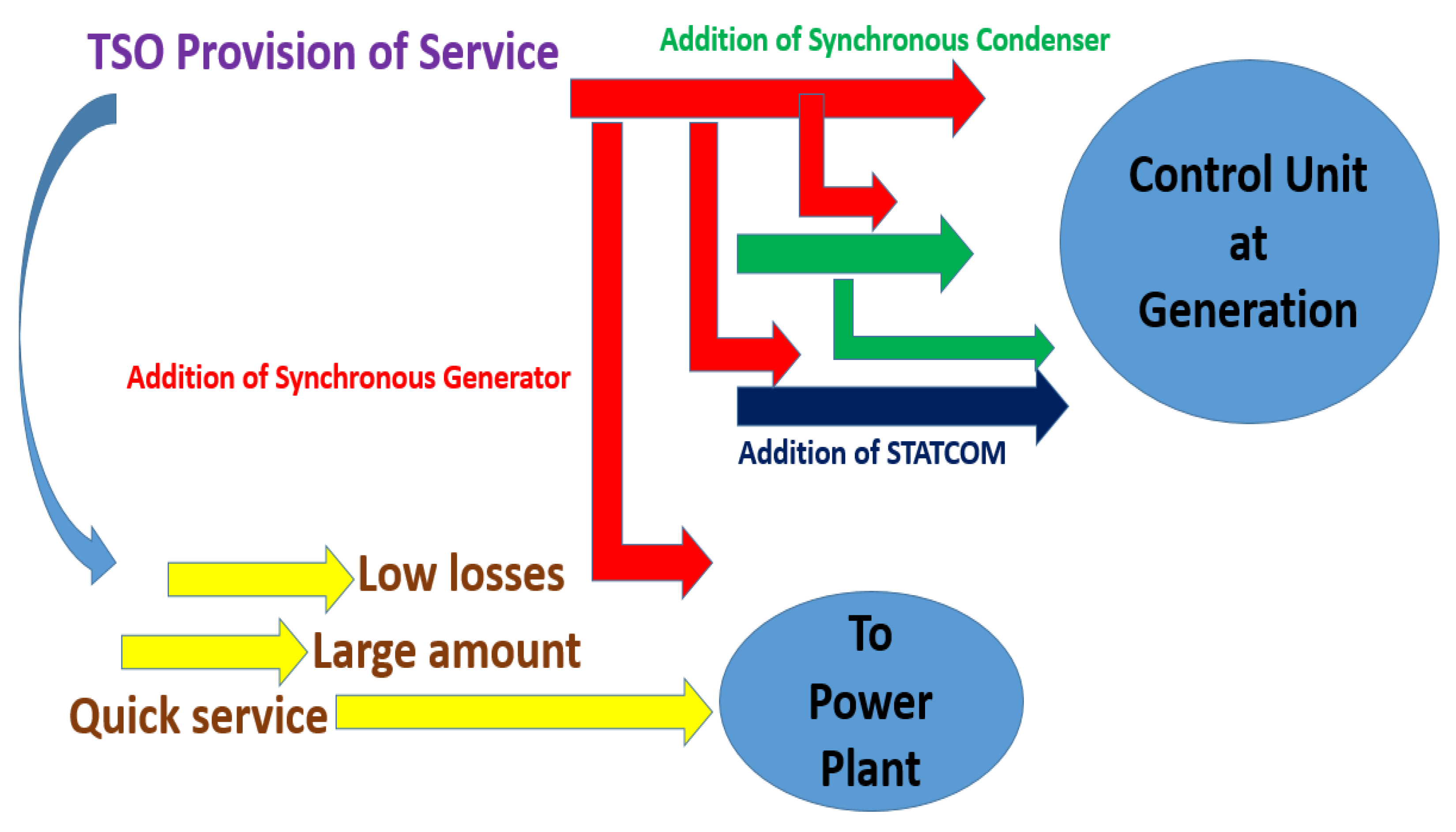
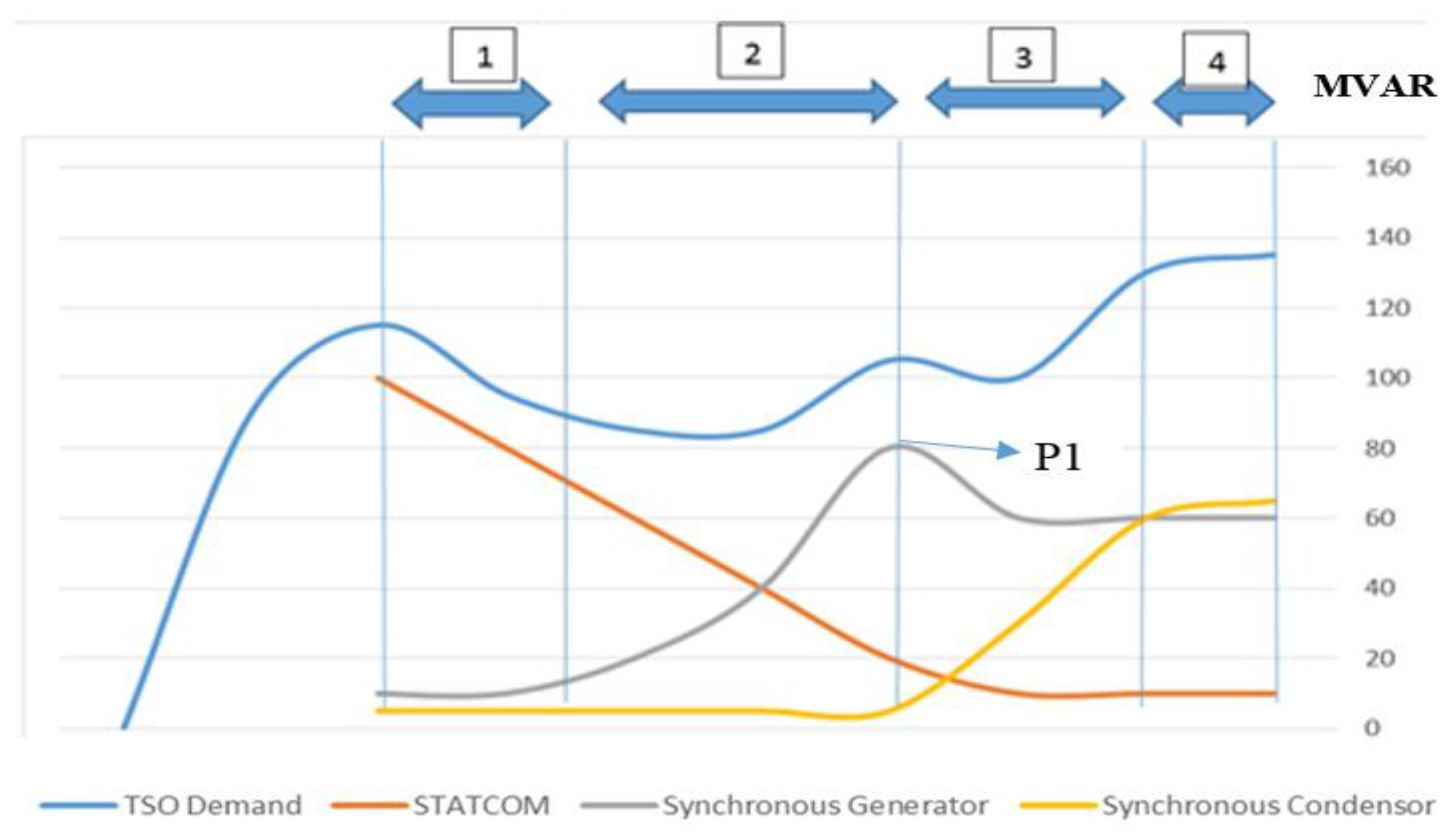
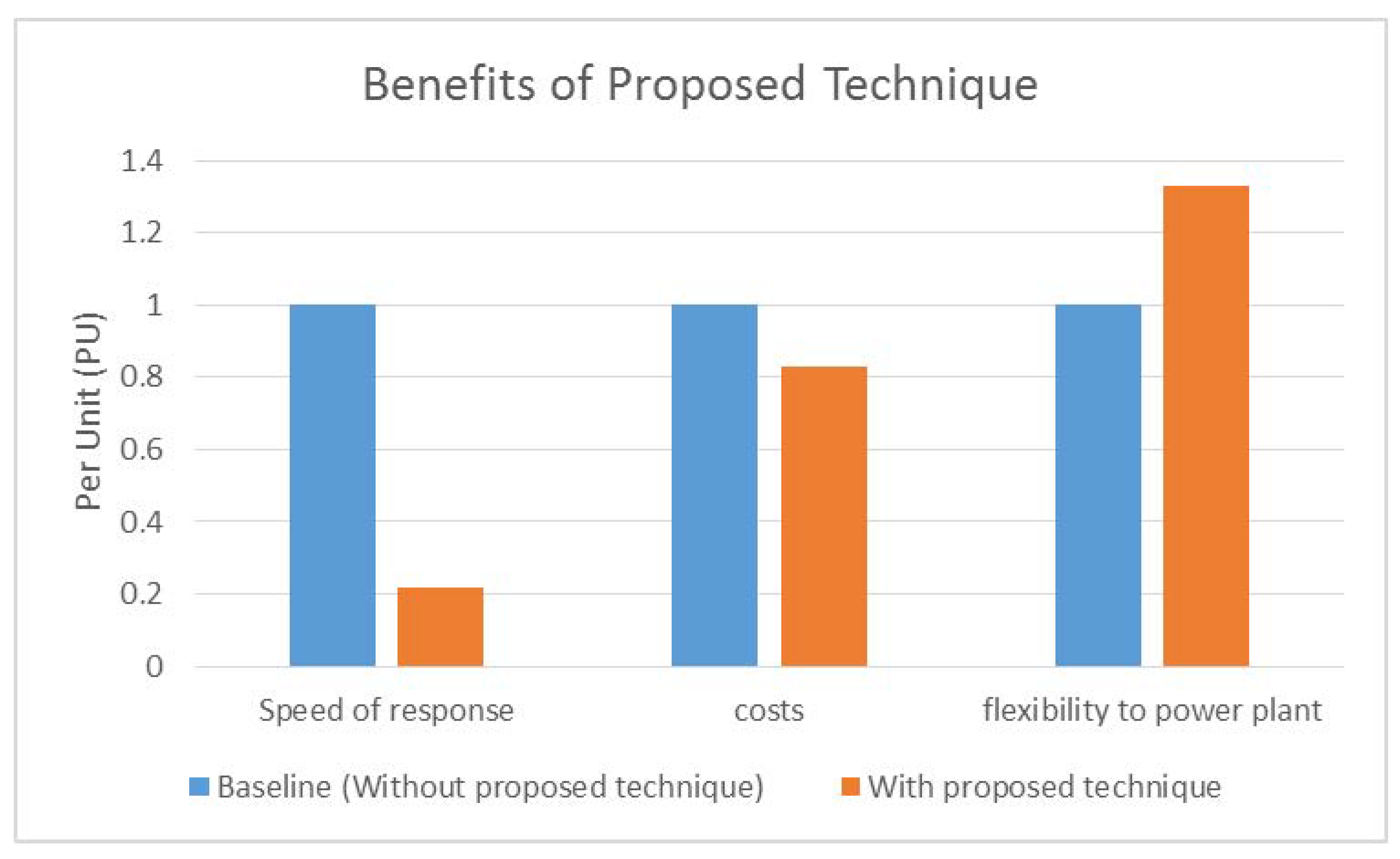
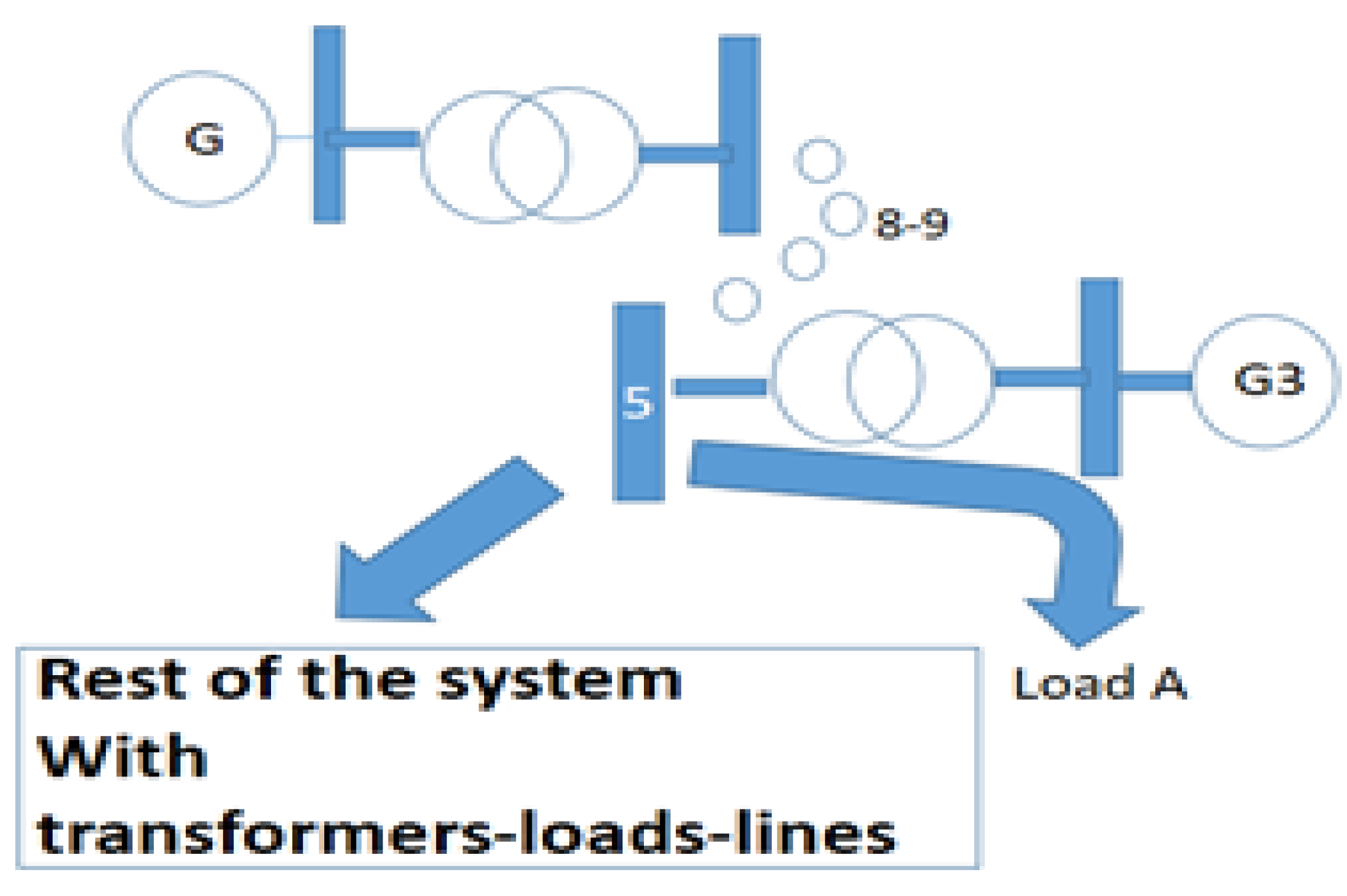
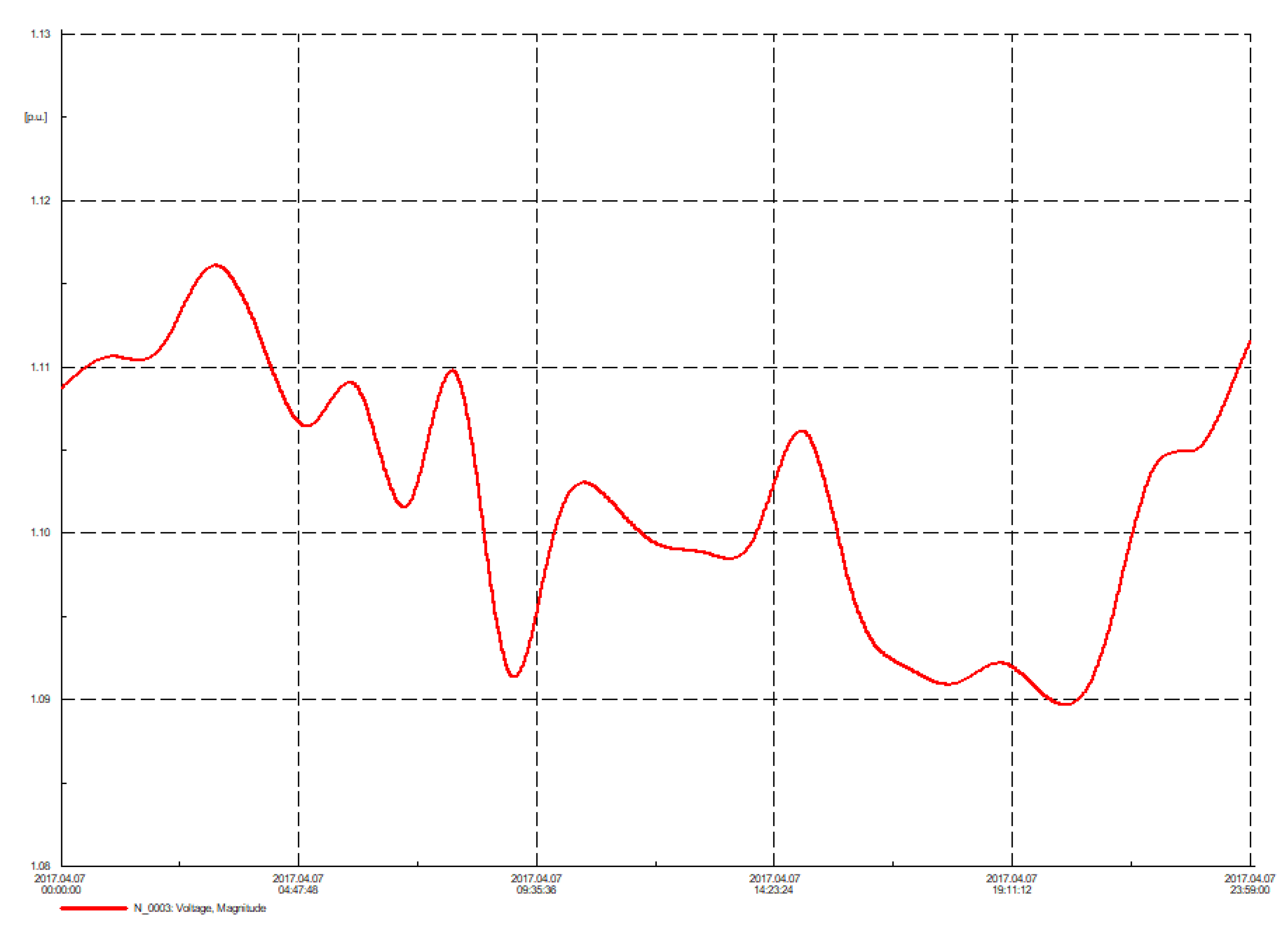

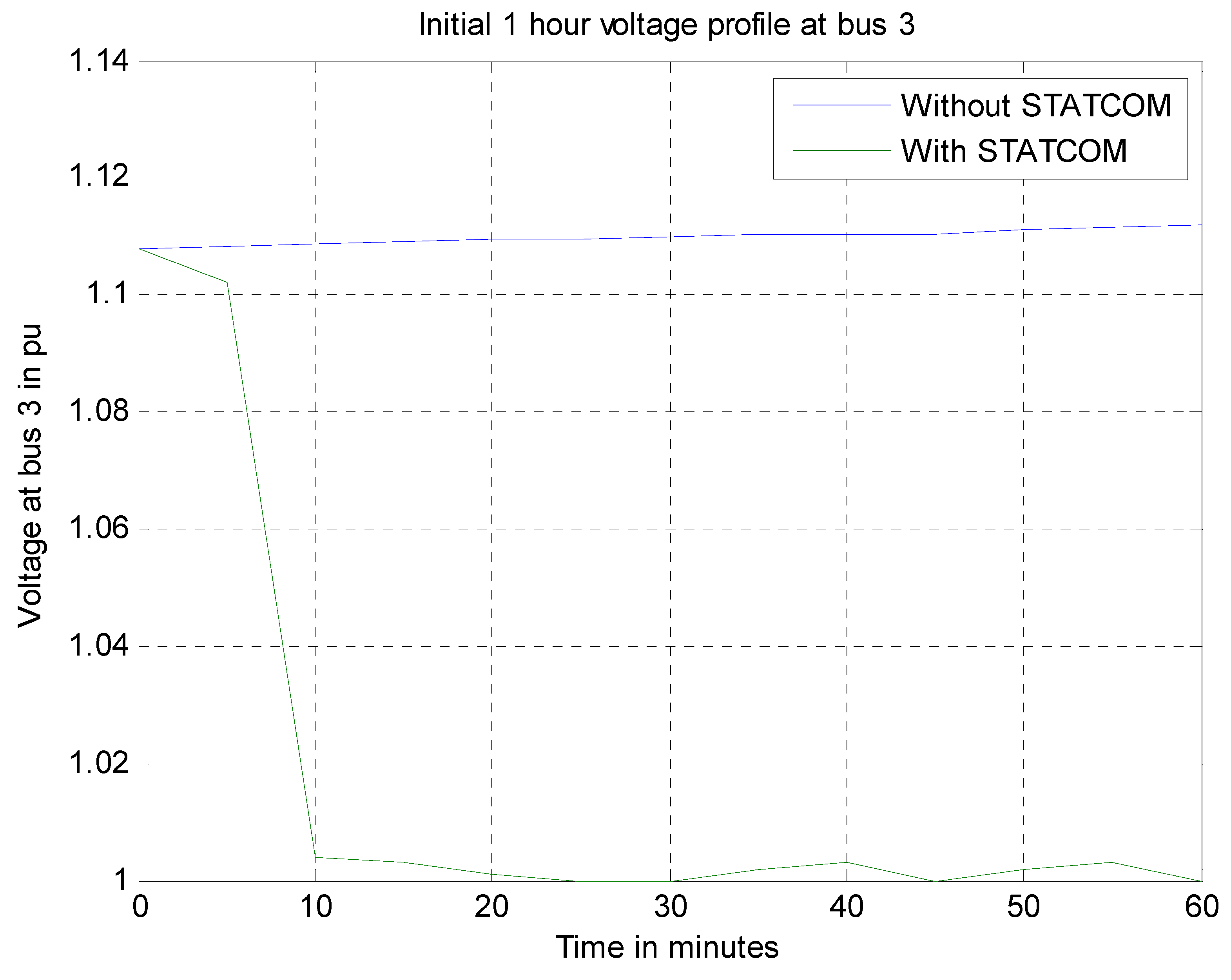
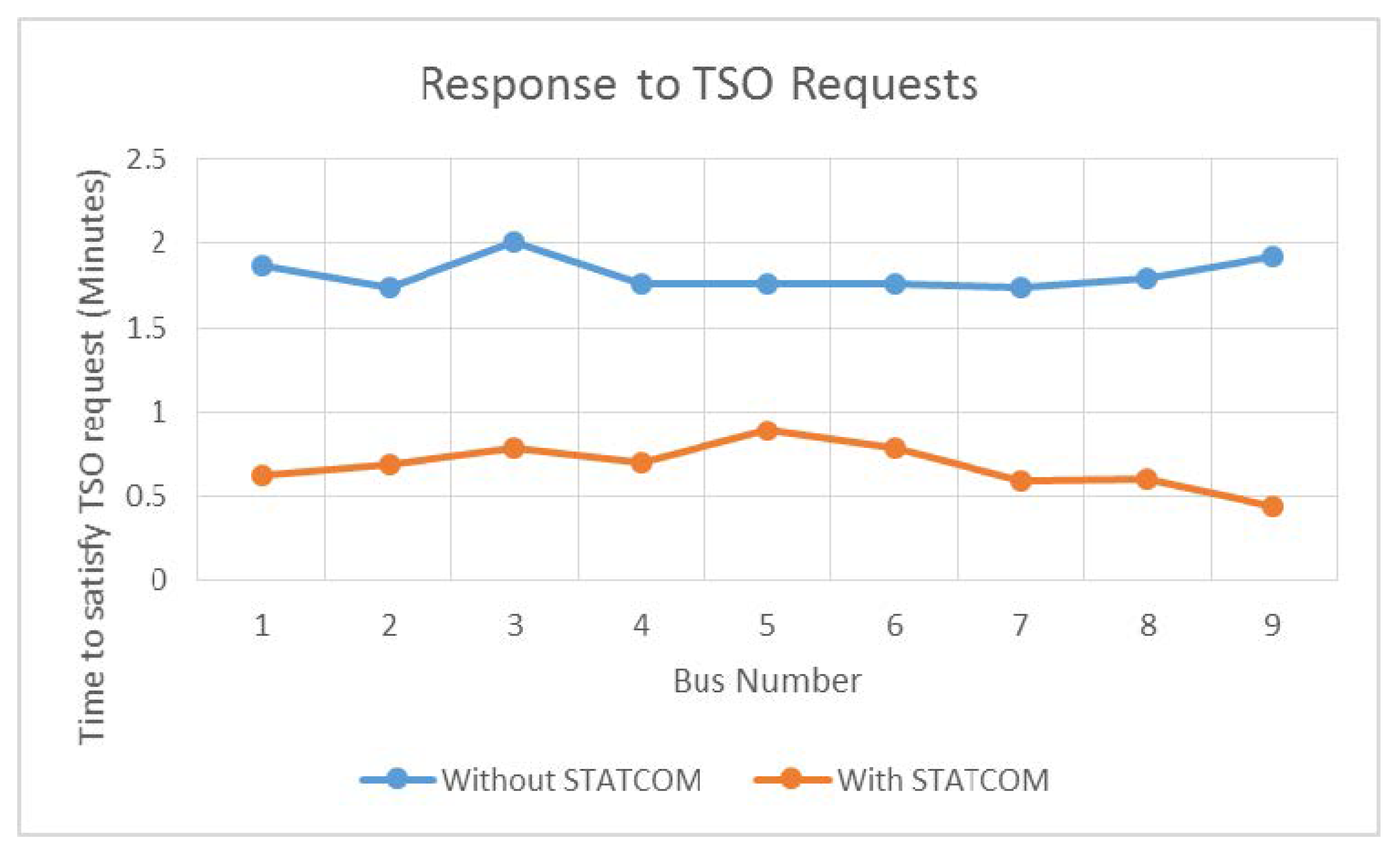
| Reactive Power Compensation Mechanism | Costs (Overall) | Efficiency | Reactive Power Capability |
|---|---|---|---|
| Synchronous Generator | Very high (specially the capital costs) | Very high | High |
| Synchronous Condenser | High (both capital and operating costs) | Very high | High |
| Capacitors | Low | Very high | Low |
| Static VAR Compensator (SVC) | Average (but the capital costs are high) | High | Low |
| STATCOM | Average (but the capital costs are high) | Low | Average |
| Inverters within Wind-PV Farms | Low (specially the operating costs) | High | Lower than SVC |
| Serial No. | Point(s) of Variation | Increase or Decrease of Reactive Power? | TSO Visibility for the Variation |
|---|---|---|---|
| 1 | Bus/Node 5 (Load A) | Increase | Decrease in demand, i.e., the distribution system requires inductive reactive power |
| 2 | Bus/Node 5 (Load A) | Decrease | Increase in demand, i.e., the distribution system requires capacitive reactive power |
| 3 | Line from node 8 to node 9 | Increase | Capacitive effect dominates on transmission network |
| 4 | Line from node 8 to node 9 | Decrease | Inductive effect dominates on transmission network |
| 5 | Bus/Node 5 (Load A) and Line from node 8 to node 9 | Increase | Overall reactive power mismatches, requires inductive reactive power |
| 6 | Bus/Node 5 (Load A) and Line from node 8 to node 9 | Decrease | Overall reactive power mismatches, requires capacitive reactive power |
| Serial No. | Element | Values of Dataset |
|---|---|---|
| 1 | Load A at Bus 5 | Real power = 250 MW, Reactive power = 50 MVAR |
| 2 | Line 8–9 | X = 30 Ohm, B = 300 Micro-Siemens |
| 3 | Generator at Node 3 | Real power = 140 MW, Reactive power = 50 MVAR |
| 4 | Additional Synchronous Generator at node 3 | Real power = 140 MW, Reactive power = 70 MVAR |
| 5 | Synchronous Condenser at node 3 | Real power = 140 MW, Reactive power = 70 MVAR |
| 6 | STATCOM at node 3 | Reactive power = 70 MVAR (inductive/capacitive) |
| Serial No. | Element | Maximum Loading in % |
|---|---|---|
| 1 | Transformer 3 | 83.725 |
| 2 | Transformer 2 | 73.273 |
| 3 | Transformer 1 | 56.647 |
| 4 | Line 4 to 5 | 32.089 |
| 5 | Line 5 to 7 | 30.225 |
| 6 | Line 6 to 9 | 21.639 |
| 7 | Line 8 to 9 | 21.334 |
| 8 | Line 7 to 8 | 11.114 |
| 9 | Line 4 to 6 | 9.911 |
| Bus | Voltage Min. [PU] without Compensation | Voltage Max. [PU] without Compensation | Voltage Min. [PU] with SG Only | Voltage Max. [PU] with SG Only | Voltage Min. [PU] with SG & SC | Voltage Max. [PU] with SG & SC |
|---|---|---|---|---|---|---|
| 3 | 0.910 | 1.206 | 0.712 | 1.184 | 1.092 | 1.116 |
| 9 | 0.927 | 1.180 | 0.977 | 1.161 | 0.967 | 1.068 |
| 8 | 0.968 | 1.140 | 0.991 | 1.123 | 0.975 | 0.995 |
| 2 | 0.905 | 1.127 | 0.996 | 1.113 | 0.901 | 0.966 |
| 7 | 0.995 | 1.127 | 0.913 | 1.113 | 0.901 | 0.967 |
| 6 | 0.921 | 1.088 | 0.976 | 1.078 | 0.911 | 0.976 |
| 4 | 0.911 | 1.058 | 0.988 | 1.054 | 0.975 | 0.977 |
| 1 | 0.981 | 1.040 | 1.011 | 1.04 | 0.968 | 1.040 |
| 5 | 0.916 | 1.039 | 0.956 | 1.031 | 0.915 | 0.977 |
© 2019 by the authors. Licensee MDPI, Basel, Switzerland. This article is an open access article distributed under the terms and conditions of the Creative Commons Attribution (CC BY) license (http://creativecommons.org/licenses/by/4.0/).
Share and Cite
Ali, J.; Massucco, S.; Silvestro, F. Aggregation Strategy for Reactive Power Compensation Techniques—Validation. Energies 2019, 12, 2047. https://doi.org/10.3390/en12112047
Ali J, Massucco S, Silvestro F. Aggregation Strategy for Reactive Power Compensation Techniques—Validation. Energies. 2019; 12(11):2047. https://doi.org/10.3390/en12112047
Chicago/Turabian StyleAli, Jibran, Stefano Massucco, and Federico Silvestro. 2019. "Aggregation Strategy for Reactive Power Compensation Techniques—Validation" Energies 12, no. 11: 2047. https://doi.org/10.3390/en12112047
APA StyleAli, J., Massucco, S., & Silvestro, F. (2019). Aggregation Strategy for Reactive Power Compensation Techniques—Validation. Energies, 12(11), 2047. https://doi.org/10.3390/en12112047







